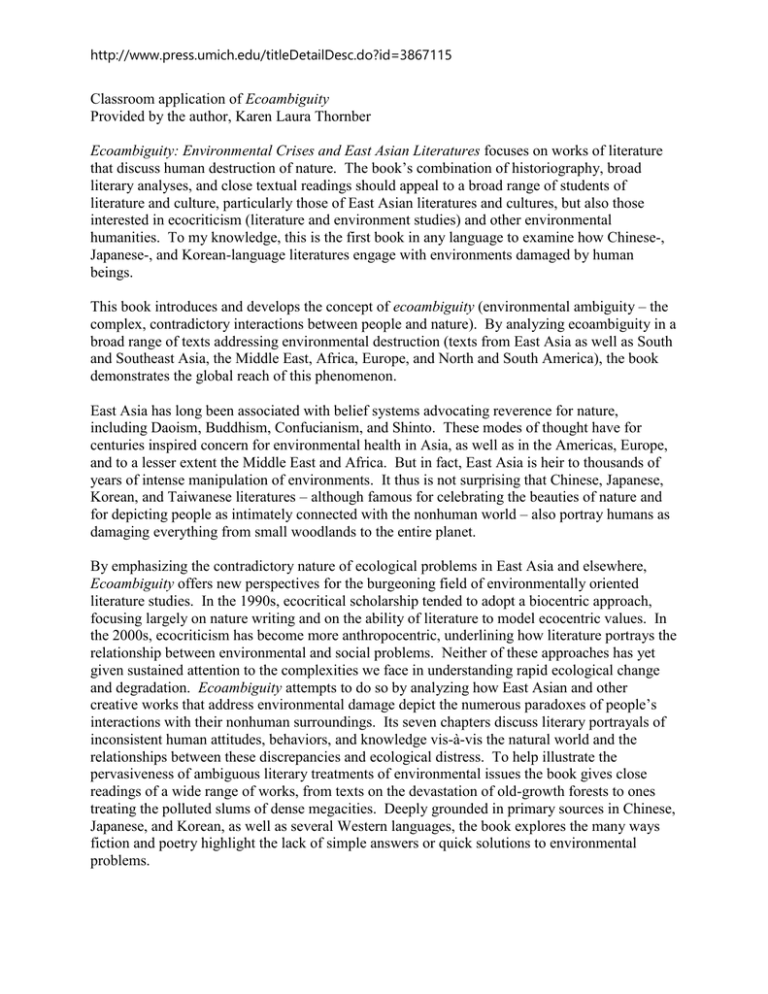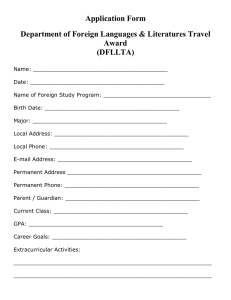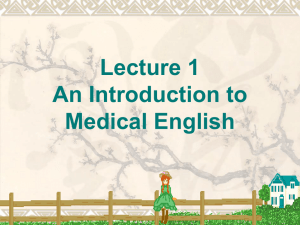Author's statement to professors
advertisement

http://www.press.umich.edu/titleDetailDesc.do?id=3867115 Classroom application of Ecoambiguity Provided by the author, Karen Laura Thornber Ecoambiguity: Environmental Crises and East Asian Literatures focuses on works of literature that discuss human destruction of nature. The book’s combination of historiography, broad literary analyses, and close textual readings should appeal to a broad range of students of literature and culture, particularly those of East Asian literatures and cultures, but also those interested in ecocriticism (literature and environment studies) and other environmental humanities. To my knowledge, this is the first book in any language to examine how Chinese-, Japanese-, and Korean-language literatures engage with environments damaged by human beings. This book introduces and develops the concept of ecoambiguity (environmental ambiguity – the complex, contradictory interactions between people and nature). By analyzing ecoambiguity in a broad range of texts addressing environmental destruction (texts from East Asia as well as South and Southeast Asia, the Middle East, Africa, Europe, and North and South America), the book demonstrates the global reach of this phenomenon. East Asia has long been associated with belief systems advocating reverence for nature, including Daoism, Buddhism, Confucianism, and Shinto. These modes of thought have for centuries inspired concern for environmental health in Asia, as well as in the Americas, Europe, and to a lesser extent the Middle East and Africa. But in fact, East Asia is heir to thousands of years of intense manipulation of environments. It thus is not surprising that Chinese, Japanese, Korean, and Taiwanese literatures – although famous for celebrating the beauties of nature and for depicting people as intimately connected with the nonhuman world – also portray humans as damaging everything from small woodlands to the entire planet. By emphasizing the contradictory nature of ecological problems in East Asia and elsewhere, Ecoambiguity offers new perspectives for the burgeoning field of environmentally oriented literature studies. In the 1990s, ecocritical scholarship tended to adopt a biocentric approach, focusing largely on nature writing and on the ability of literature to model ecocentric values. In the 2000s, ecocriticism has become more anthropocentric, underlining how literature portrays the relationship between environmental and social problems. Neither of these approaches has yet given sustained attention to the complexities we face in understanding rapid ecological change and degradation. Ecoambiguity attempts to do so by analyzing how East Asian and other creative works that address environmental damage depict the numerous paradoxes of people’s interactions with their nonhuman surroundings. Its seven chapters discuss literary portrayals of inconsistent human attitudes, behaviors, and knowledge vis-à-vis the natural world and the relationships between these discrepancies and ecological distress. To help illustrate the pervasiveness of ambiguous literary treatments of environmental issues the book gives close readings of a wide range of works, from texts on the devastation of old-growth forests to ones treating the polluted slums of dense megacities. Deeply grounded in primary sources in Chinese, Japanese, and Korean, as well as several Western languages, the book explores the many ways fiction and poetry highlight the lack of simple answers or quick solutions to environmental problems. http://www.press.umich.edu/titleDetailDesc.do?id=3867115 In addition to proposing a new model and fresh vocabulary for analyzing writing on devastated environments, Ecoambiguity also attempts to widen the geographic scope of ecocriticism. In the United States most ecocritical scholarship has drawn from American and European literatures; in recent years there has been increased ecocritical interest in the Western-language literatures of Africa, Latin America, and South Asia. Even in East Asia, research on literature and damaged environments has focused disproportionately on Western-language examples. In the coming years, ecocritics will need to address a broader range of literatures, including those from East Asia. Ecoambiguity likewise contributes to an emerging subfield within East Asian Studies. Researchers in the social and natural sciences have written extensively on East Asia’s environmental problems, the many movements and organizations that have fought against ecological degradation, and official responses on local, national, and regional levels. Much also has been written on East Asian literary depictions of people revering and identifying closely with their natural surroundings. Yet scholarship that examines how East Asian literatures have discussed human-induced damage to environments is still in its early stages both in East Asia and outside the region. By discussing texts from across East Asia and around the world, the book also helps to cement the place of comparative modern East Asian literatures within the broader field of comparative literature. In addition, by including creative writings that have had a significant presence in literary systems beyond those of their source cultures, Ecoambiguity contributes to developing a subfield of world literature and environment. World literature generally is understood as the subset of creative texts that have actively circulated beyond their cultures of origin, whether in translation or in their original language; although many works of world literature address human damage to the nonhuman, surprisingly little scholarship has focused on how these texts confront ecological degradation. More important, Ecoambiguity argues that texts that grapple with global problems, including environmental degradation, should be read as world literature – in other words, that we examine how they reach beyond their source cultures – regardless of whether the texts themselves have been successful in one or more societies.



